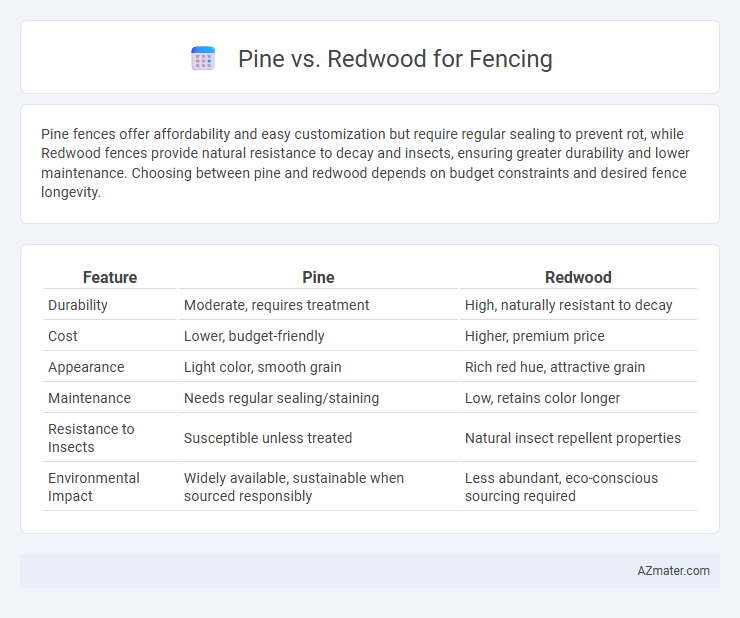Pine fences offer affordability and easy customization but require regular sealing to prevent rot, while Redwood fences provide natural resistance to decay and insects, ensuring greater durability and lower maintenance. Choosing between pine and redwood depends on budget constraints and desired fence longevity.
Table of Comparison
| Feature | Pine | Redwood |
|---|---|---|
| Durability | Moderate, requires treatment | High, naturally resistant to decay |
| Cost | Lower, budget-friendly | Higher, premium price |
| Appearance | Light color, smooth grain | Rich red hue, attractive grain |
| Maintenance | Needs regular sealing/staining | Low, retains color longer |
| Resistance to Insects | Susceptible unless treated | Natural insect repellent properties |
| Environmental Impact | Widely available, sustainable when sourced responsibly | Less abundant, eco-conscious sourcing required |
Overview: Pine vs Redwood as Fence Materials
Pine and redwood are popular choices for fencing, each offering distinct benefits based on durability and aesthetics. Pine is a cost-effective option with moderate decay resistance but requires pressure treatment to withstand moisture and pests. Redwood naturally resists rot and insects due to its tannins, providing a longer-lasting, visually appealing fence with less maintenance.
Durability and Longevity Comparison
Redwood offers superior durability and longevity compared to pine due to its natural resistance to decay, insects, and moisture, making it ideal for outdoor fencing in harsh climates. Pine fencing requires chemical treatment to enhance its lifespan, typically lasting around 10-15 years, whereas redwood fences can endure 20-30 years or more with minimal maintenance. The high tannin content in redwood woods contributes to its robust resistance, providing long-term protection against weathering and structural deterioration.
Appearance and Grain Differences
Pine fences typically feature a lighter, pale yellow to white hue with a straight, uniform grain that offers a clean, smooth appearance ideal for staining or painting. Redwood fences showcase a rich, reddish-brown color with a pronounced, interlocked grain pattern that adds natural texture and visual depth. The contrasting grain characteristics influence durability and aesthetic appeal, with pine providing a more polished look and redwood delivering a rustic, distinctive charm.
Resistance to Pests and Decay
Redwood naturally contains tannins that provide strong resistance to pests and decay, making it a durable choice for fencing in moist or termite-prone areas. Pine, often treated with chemical preservatives, offers good protection against insects and rot but may require more frequent maintenance to maintain its integrity over time. The inherent pest and decay resistance of redwood generally results in a longer-lasting fence compared to treated pine.
Environmental Impact and Sustainability
Pine fences offer faster growth rates and better carbon sequestration due to shorter rotation periods compared to redwood, making pine a more renewable resource. Redwood, though longer-lasting and naturally resistant to decay, often comes from old-growth forests, raising concerns about deforestation and habitat loss. Sustainable sourcing certifications like FSC for pine ensure eco-friendly practices, while redwood alternatives emphasize reclaimed wood to minimize environmental impact.
Maintenance Requirements
Pine fences require regular sealing or staining every 1-2 years to prevent moisture damage and insect infestation, as pine is softer and more susceptible to rot. Redwood fences offer superior natural resistance to decay and insects, reducing maintenance frequency to every 3-5 years for staining or sealing. Proper maintenance of both wood types significantly extends fence lifespan and preserves aesthetic appeal.
Cost Analysis: Pine vs Redwood
Pine fences typically cost between $10 to $15 per linear foot, making them a budget-friendly option for homeowners seeking affordable fencing solutions. Redwood fences range from $25 to $40 per linear foot, reflecting their premium quality, natural resistance to decay, and longer lifespan. While pine requires more frequent maintenance and replacement, redwood's durability can reduce long-term expenses despite the higher initial investment.
Ease of Installation
Pine fences are easier to install due to their lighter weight and uniform texture, allowing for quicker cutting and nailing. Redwood, while heavier and denser, requires more careful handling but offers natural resistance to warping, reducing the need for adjustments during installation. Both materials benefit from pre-drilling to prevent splitting, but pine's softness generally speeds up the overall fencing project.
Regional Availability
Pine fences are widely available across North America, especially in the Southeastern United States where Southern Yellow Pine is abundant and cost-effective. Redwood, native to the Western United States, particularly California and Oregon, is regionally limited but highly prized for its natural resistance to decay and aesthetic appeal. Homeowners in regions outside the West Coast may face higher costs and limited supply when choosing redwood for fencing compared to readily accessible pine options.
Best Choice for Your Fence Project
Redwood offers superior natural resistance to decay and insects compared to pine, making it a long-lasting and low-maintenance option for fencing projects. Pine fences, while more affordable and easier to paint or stain, require regular treatment to prevent rot and insect damage. For durability and aesthetic appeal, redwood is the best choice, especially in climates prone to moisture and pest issues.

Infographic: Pine vs Redwood for Fence
 azmater.com
azmater.com